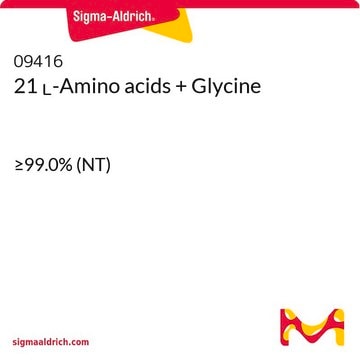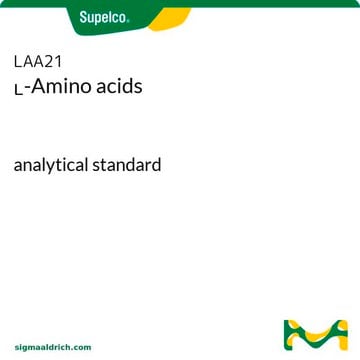B6766
BME Amino Acids Solution 50×
Without L-glutamine, sterile-filtered, BioReagent, suitable for cell culture
Synonym(s):
Amino Acids Solution
Sign Into View Organizational & Contract Pricing
All Photos(1)
About This Item
UNSPSC Code:
12352209
NACRES:
NA.75
Recommended Products
sterility
sterile-filtered
product line
BioReagent
form
solution
technique(s)
cell culture | mammalian: suitable
impurities
endotoxin, tested
shipped in
ambient
storage temp.
2-8°C
Application
BME amino acids solution 50X has been used for embryo culture.
supplement
Product No.
Description
Pricing
Storage Class Code
12 - Non Combustible Liquids
WGK
WGK 2
Flash Point(F)
Not applicable
Flash Point(C)
Not applicable
Certificates of Analysis (COA)
Search for Certificates of Analysis (COA) by entering the products Lot/Batch Number. Lot and Batch Numbers can be found on a product’s label following the words ‘Lot’ or ‘Batch’.
Already Own This Product?
Find documentation for the products that you have recently purchased in the Document Library.
Customers Also Viewed
Tianbin Liu et al.
Cellular reprogramming, 22(6), 282-290 (2020-11-13)
Essential amino acids (EAA) of inappropriate concentration have been reported to compromise the development of embryo. This study aimed to investigate the effect of EAA on the developmental competence of porcine embryos produced by either handmade cloning (HMC) or parthenogenetic
Combination of oviduct fluid and heparin to improve monospermic zygotes production during porcine in vitro fertilization
Batista RITP, et al.
Theriogenology, 86(2), 495-502 (2016)
Influence of sperm fertilising concentration, sperm selection method and sperm capacitation procedure on the incidence of numerical chromosomal abnormalities in IVF early bovine embryos
Demyda-Peyras S, et al.
Reproduction, Fertility, and Development, 27(2), 351-359 (2015)
Different co-culture systems have the same impact on bovine embryo transcriptome
Carvalho AV, et al.
Reproduction (Cambridge, England), 154(5), 695-710 (2017)
Jun Song et al.
Scientific reports, 7(1), 12202-12202 (2017-09-25)
Immunodeficient mice have been used predominantly in biomedical research. Realizing that large animal species may have an enhanced ability to predict clinical outcome relative to mice, we worked to develop immunodeficient rabbits by CRISPR/Cas9. We first demonstrated that multiplex embryo
Our team of scientists has experience in all areas of research including Life Science, Material Science, Chemical Synthesis, Chromatography, Analytical and many others.
Contact Technical Service










